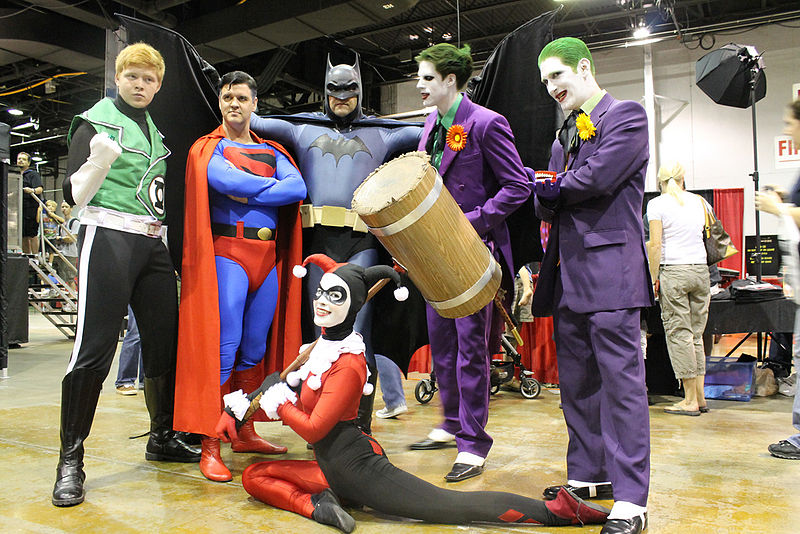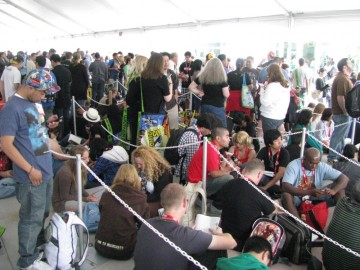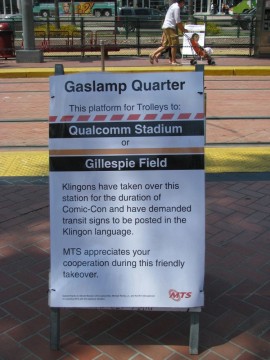
By Kimra McPherson
Comic-Con International, the annual celebration of fan culture, is under way in San Diego. From the outside, it looks like a blur of costumes, superhero news, TV and movie gossip, and maybe a graphic novel or two. But there's plenty happening at Comic-Con that you wouldn't necessarily discover unless you entered nerddom's most hallowed halls. As a two-time veteran of Comic-Con (2008 and 2010), I've still only seen a sliver of the sprawling event, which continues to expand beyond the San Diego Convention Center walls and gobble up every hotel ballroom in its sights. But those trips were enough to discover these five essential things about Comic-Con that I wouldn't have known had I not experienced them for myself.
 A lot of Comic-Con is standing in lines. Lines to get into the convention center. Lines to get into panel rooms. Lines to get free posters. Lines to buy stale pretzels. Lines to get things signed. Lines to get the shuttle back to the hotel (that is six blocks away). Lines that intersect in such complicated ways that there's a whole system of hallway crossings. Once, when I was trying to get into a Mystery Science Theater 3000 panel, security guards capped the official line — so then there was a line to get in line. But the lines aren't all bad. They're where some of the best socializing happens — since once you get inside a panel room, you're mostly not talking — and there can be a "we're all in this together" vibe, a collective realization that waiting for hours to see famous people very far away talk about a movie you haven't seen yet is kind of dumb, but you're all going to do it anyway.
A lot of Comic-Con is standing in lines. Lines to get into the convention center. Lines to get into panel rooms. Lines to get free posters. Lines to buy stale pretzels. Lines to get things signed. Lines to get the shuttle back to the hotel (that is six blocks away). Lines that intersect in such complicated ways that there's a whole system of hallway crossings. Once, when I was trying to get into a Mystery Science Theater 3000 panel, security guards capped the official line — so then there was a line to get in line. But the lines aren't all bad. They're where some of the best socializing happens — since once you get inside a panel room, you're mostly not talking — and there can be a "we're all in this together" vibe, a collective realization that waiting for hours to see famous people very far away talk about a movie you haven't seen yet is kind of dumb, but you're all going to do it anyway.
Comic-Con programming reveals any gulf between something's perceived popularity and its actual fan support. Granted, Comic-Con doesn't cater to every audience, so it's not a representative sample. But it's still interesting when something in a smaller room draws three times the crowd that can actually fit inside, or when something in one of the huge rooms barely gets warm bodies in half the seats. It can be a first sign that a once-beloved property is dying or that a previously ignored one has suddenly grabbed a new audience. A couple of years ago, many of the biggest TV shows got showcases in the Con's largest hall, a sign of TV's cultural ascendency (or, just a sign that it wasn't a great year for movies). It's not a perfect cultural barometer, but it's a pretty good survey of those most inclined to be obsessive when they love something.
You have to sit through a lot of things you don't care about just to get to the one you do. Let's say the one thing you want to do, more than anything, is to see the panel for True Blood (this year, Saturday at 5 pm). Because of the aforementioned lines — and because once you're in a room, you've got your seat for the day, since nobody kicks the crowd out between sessions — the only way to guarantee your spot is to get in early. The price of your coveted Ballroom 20 seat? Sitting through panels on things you might not even enjoy, like American Dad or Grimm. That said, ballroom-squatting is where some of the best discovery at Comic-Con happens. Since you can't really leave, you might as well find your new favorite thing while you wait for your old favorite thing to take the stage.
 If you don't know what it is, it's probably marketing.
If you don't know what it is, it's probably marketing. 
